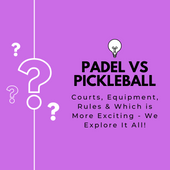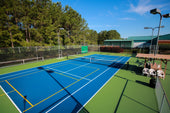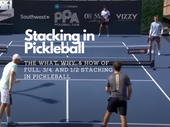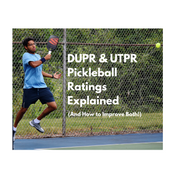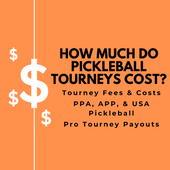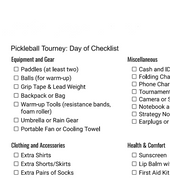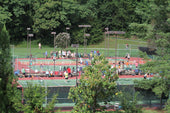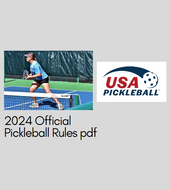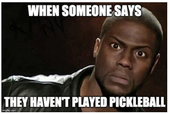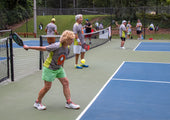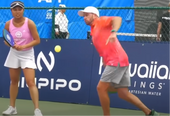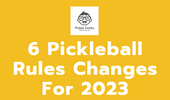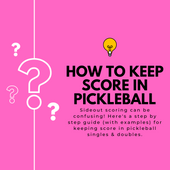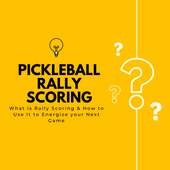As the fastest growing sport in the US, pickleball is attracting players of all ages and skill levels.
Whether you're a beginner or an advanced pro, understanding the different skill levels in pickleball is important for a number of reasons, including:
- Finding entertaining gameplay with comparable players
- Placement in pickleball tournaments, and
- Knowing what you need to work on to get better!
In this article, we'll look at the official pickleball skill level definitions as provided by the sport’s governing body - the USA Pickleball Association (USAPA). We’ll also highlight how to get a rating and which rating (Skills, UTPR or DUPR) you should target!
What are Pickleball Skill Levels?
The USAPA has established a standardized pickleball skill-level rating system to classify players based on their proficiency in the sport. These ratings range from 1.0 (beginner) to 5.5 (advanced/professional).
For example, key skills for a 4.0 pickleball player include:

USAPA defines each skill level based on the ability of a player to perform certain shots on the court.
This includes simpler actions like hitting the pickleball in the court consistently to more advance shots like drives, dinks, and using different spins and speeds as needed.
Although not very user-friendly, USAPA summarizes the different skill levels in this pickleball skill level chart.
We'll summarize each skill level in the following sections - and also include drills and video examples of what each skill level looks like - to help you identify where you currently stand and what it takes to reach the next level!
Beginner Pickleball Skills: 1.0 to 2.5 Skill Level
At the 1.0 to 2.5 skill levels, players are just starting their pickleball journey and are learning how to hold and swing the paddle, the basics of footwork, and how to keep score.
At the 1.0 to 2.5 level, players will frequently miss shots (serves, returns of serve, volleys, etc) and are learning to keep score and understand the rules (e.g., the no volley zone, aka kitchen, and the 2 bounce rule) of pickleball.
Check out this video to see what quality 2.5 level pickleball looks like:
How to Get from a 2.5 to a 3.0 Pickleball Rating
To advance from a 2.5 to a 3.0, players should strive to:
- Learn the basic rules of pickleball, including how to keep score
- Hit forehand groundstrokes and volleys in the court at least 70% of the time (against similar-level opponents).
- Hit 70% of returns and serves into the court
- Begin learning how to hit 3rd shot drops as well as dinks
To develop these skills, it’s important to practice and not just play games. Games are fun, social, and exciting, but all players at every level need the repetitions from practice to improve!
A few drills that can help you improve from a 2.0 to a 3.0 are:
- Hit cross court rallies with a partner, 5 minutes of forehands and 5 minutes of backhands. Focus on footwork and contacting the ball in front of your body each time.
- Practice cross court dinks for 10 minutes per side (forehand and backhand).
- Play 1-2 games of skinny singles, focusing on keeping the ball in play and minimizing errors.
If you are just getting started (or looking to teach someone who is new to the game), try a few of these drills to help with technique:
What is a 3.0 Pickleball Player?
At the 3.0 pickleball levels, players understand the basics of pickleball and are beginning to build competence in key skills.
A 3.0 pickleball player can hit medium-paced forehands, volleys, serves, and returns, but is unable to always control depth and consistency. This means short points and rallies as mistakes are common.
At the 3.0 skill level players will usually struggle to:
- Put the pickleball in play consistently (> 75% of the time)
- Hit backhands
- Sustain dink rallies
- Hit 3rd shot drops
What is a Level 3.5 Pickleball Player?
According to USAPA, a 3.5 level pickleballer has learned to control forehands, serves, returns, and volleys, and can place these shots in the court on a consistent basis. He or she also understands basic strategy, including the importance of getting to the net.
The 3.5 player is also starting to develop their backhand and 3rd shot drop shot and can sustain medium-length dink rallies, but struggles to control these shots or hit them consistently.
How to Get from a 3.0 to a 3.5 Pickleball Level
Consistency is the name of the game at every level of pickleball, from the 3.0 level to touring pros. In almost any game, more points are lost than won, so it’s critical to develop patience during points and consistency in shot execution (i.e., limit mistakes at all costs!).
As noted above, the best way to quickly improve pickleball skills is through practice and drilling. In addition to the drills mentioned above, players striving to move from 3.0 to 3.5 can also practice:
- Hitting down the line rallies, with 1 partner hitting forehands and the other backhands.
- 3rd shot drops - have 1 partner stand at the kitchen line and the other at the service line. The player at the service line practices hitting the pickleball short and soft to the player at the kitchen line.
We also like the drills highlighted in this video:
What is a 4.0 Pickleball Player?
Reaching the 4.0 skill level marks a significant milestone in a pickleball player's journey, so let’s look at a 4.0 player’s ability stroke by stroke:
- Forehand: Consistently hits with depth and control, learning shot selection to create advantages in point.
- Backhand: Has learned mechanics and can hit backhand in court consistently. May struggle with power, control, and placement.
- Serve/Return: Hits majority (>90%) serves/returns in play, and can sometimes vary speed and depth.
- Dinks: Has learned to dink consistently but may still struggle with height over net and placement at times.
- 3rd Shot: Can execute 3rd shot drops and sometimes drives the 3rd shots to create an advantage.
- Volley: Can hit a variety of volleys at different speeds. Starting to understand speed-ups and blocks/re-sets.
- Strategy: Full grasp of pickleball rules and strategies like stacking and targeting an opponent’s weakness. Still makes a moderate number of errors due to impatience or decision-making.
What is a 4.5 Pickleball Player?
At the 4.5 skill level, players have developed consistency in most shots and also possess strengths and weapons used to attack during points.
Let's take a look at 4.5 level pickleball from the 2023 US Open 4.5 Pickleball Championship match:
As you can see from this video, 4.5 players can:
- Hit forehands, serves and returns with very few mistakes, while varying speed, spin and placement. Forehands are often a strength for 4.5 and above players.
- Hit backhands at a medium pace while controlling depth and placement.
- Dink consistently and offensively, looking to attack when opponent’s hit a weak shot.
- Effectively hit 3rd shot drives and drops, consistently executing 1-2 shots to get to the kitchen line for a dink rally.
- Speed up volleys and return balls that are sped up at them.
- Adjust strategy based on opponent, limit unforced errors, and are comfortable playing either side of the court
How to Get from a 4.0 to a 4.5 Pickleball Rating
Once players reach the 4.0 level it usually takes more time to move to a new skill level than it did moving from a 3.0 to 3.5.
To move from a 4.0 to 4.5, players should continue working on the foundational skills of pickleball, mainly dinks, drops, and drives.
At this point it makes sense to invest in a pickleball basket full of pickleballs, and even having a ball machine may be a worthwhile investment.
This video has several good drills that help players work on technique, shot-making, and footwork:
In addition, players should also work on:
- Improving their serve: Serves can be an offensive weapon, and practicing is easy. Place a paddle cover within 2 feet of the service line and practice hitting it using deep, hard serves. Aim to practice hitting at least 100 serves each practice session.
- Work on hand speed: As play gets more advanced, speed ups aka fire fights) are much more common while players are at the kitchen line. It’s important to react quickly when a ball is sped up in your direction. To practice, grab a partner and stand at the kitchen line opposite of one another. Simply practice volleying quickly at one another, aiming not to hit winners but to hit the ball back at one another to sustain rallies of 10 or more shots.
- Find players better than you are and play games with them. This is a great way to learn technique, strategy, and to challenge your skills under pressure from better players.
What is a 5.0 Pickleball Player?
At the 5.0 and 5.5 skill levels, players are considered elite and often compete in tournaments and at the professional level.
5.0 and 5.5 level pickleball players can execute almost any shot, adjusting speed and depth as needed, and are adept at in-point decision making. 5.0 players limit mistakes and errors, attack when appropriate, and play defensively if the opponent has the advantage.
For example, take a look at the skills exhibited by the players in this video - shot selection, shot execution, anticipation, and patience all while looking for an opportunity to attack!
More specifically, 5.0 and 5.5 players:
- Hit all shot types - groundstrokes, volleys, dinks, and drops - at a high level of ability from either the forehand or backhand side using touch, spin, and pace with control to set up offensive situations.
- Have developed good touch from all court positions. Can drop or drive the ball effectively from both the forehand and backhand side.
- Possess a very high level of variety, depth, and pace of serves and returns.
- Can speed up volleys when given the opportunity and are able to block hard volleys directed at them and consistently drop them into the kitchen. Also able to volley shots toward opponents feet consistently and are comfortable with swinging volleys to attack
Most importantly, though, 5.0 and 5.5 players have developed extreme patience and work hard (in practice and matches) to limit unforced errors.
How to Determine Your Pickleball Rating and Skill Level
Wondering how to determine your pickleball rating and skill level? There are a few options you can choose.
Pickleball Skills Assessment by a Pro
Professional players as well as teaching pros will have intimate knowledge of the USAPA ranking system, and by observing you in play will be able to judge accurately just how far up the ladder you are. Trust their advice - they’re level 5.0+ for a reason!
Pickleball Self-rating
Using the details above, rate yourself! As long as you are honest and have a realistic view of your pickleball abilities, you can use this info to accurately determine your rating and skill level.
USAPA also offers skills assessment sheets on their site (but they don't do a great job explaining what rating a player should have at the end of the assessment!):

Pickleball Tournament Rating
If you don’t know your level and aren’t afraid to find out the hard way, enter a few pickleball tournaments. For better or for worse, USAPA will assign a UTPR rating after you have played a few tournaments. Use this experience and rating to improve your game for good!
DUPR vs UTPR
In addition to a USAPA skills assessment, many players (especially ones playing tournaments) also have both of the following ratings:
- USA Tournament Player Rating (UTPR)
- Dynamic Universal Pickleball Rating (DUPR)
Both rating systems are based on a player’s won/loss record against other rated players, but the 2 ratings systems go about their ratings differently (we highlighted how both work, how they compare, and which is more reliable here).
UTPR ratings will be automatically assigned once you have played a tournament or 2, but for DUPR ratings you’ll need to sign up for an account.
Once you have an account, you can enter recreational play results and tournament results should automatically be added to your profile and rating.
Final Thoughts: Pickleball Skill Levels
Having used all of the systems and ratings methods in this article, we believe DUPR is the most accurate skills rating and rankings method in pickleball.
Although not without a few faults, the DUPR system is easy to understand, based on a statistical/math model, and is updated on a regular basis.
If your goal is to truly understand your skill level and rating, we recommend getting 20 games entered in your DUPR profile and you’ll have a reasonably accurate assessment of your skill level.
Thanks for reading and happy pickling!






